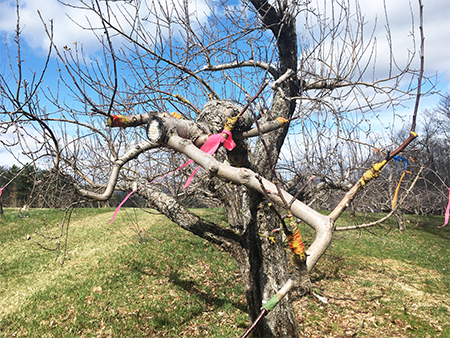This year Steve's selected certain old trees for a research project run by UMass.
 It's an experiment, based on the fact that certain apple varieties are extremely attractive to certain apple pests. So the question is: we graft a few branches of super-attractive varieties into a few trees in an orchard, will the pests bunch up on those trees? Will they ignore the other trees? If it actually works that way, then a whole population of damaging pests might be stopped in those small areas. They couldn't go on to damage the small growing fruit throughout the orchard. This is the kind of basic applied science that has continually improved orcharding for many decades. (We, and other growers in our region, have supported university-led field research for many years, by hosting experiments.)
It's an experiment, based on the fact that certain apple varieties are extremely attractive to certain apple pests. So the question is: we graft a few branches of super-attractive varieties into a few trees in an orchard, will the pests bunch up on those trees? Will they ignore the other trees? If it actually works that way, then a whole population of damaging pests might be stopped in those small areas. They couldn't go on to damage the small growing fruit throughout the orchard. This is the kind of basic applied science that has continually improved orcharding for many decades. (We, and other growers in our region, have supported university-led field research for many years, by hosting experiments.)The techniques of grafting can accomplish a lot of magic effects. For example: you've planted young trees, and later decide you'd rather grow different apples. Cut the trees right off it, graft sticks (scions) of new varieties into the stubs, wait a few years, and get the apples you want! There are many techniques and uses for grafting, some that require extreme skill, speed and finesse. Plant grafting has gone on worldwide for thousands of years, throughout horticulture. Here in our corner we've done thousands of basic grafts over decades. But there's a new thrill every time a little stick joins itself to a standing tree and unfolds new leaves, just a few weeks after the operation!
Later we'll put up some photos of these grafts once they leaf out.
 These pictures show pretty simple small whip-and-tongue grafts.
These pictures show pretty simple small whip-and-tongue grafts. Anyone can learn to do this, especially if they study The Grafter's Handbook, by R.J.Garner. That was our grafting school.
Bye for now. More later. We hope you are doing OK during April of 2020.


